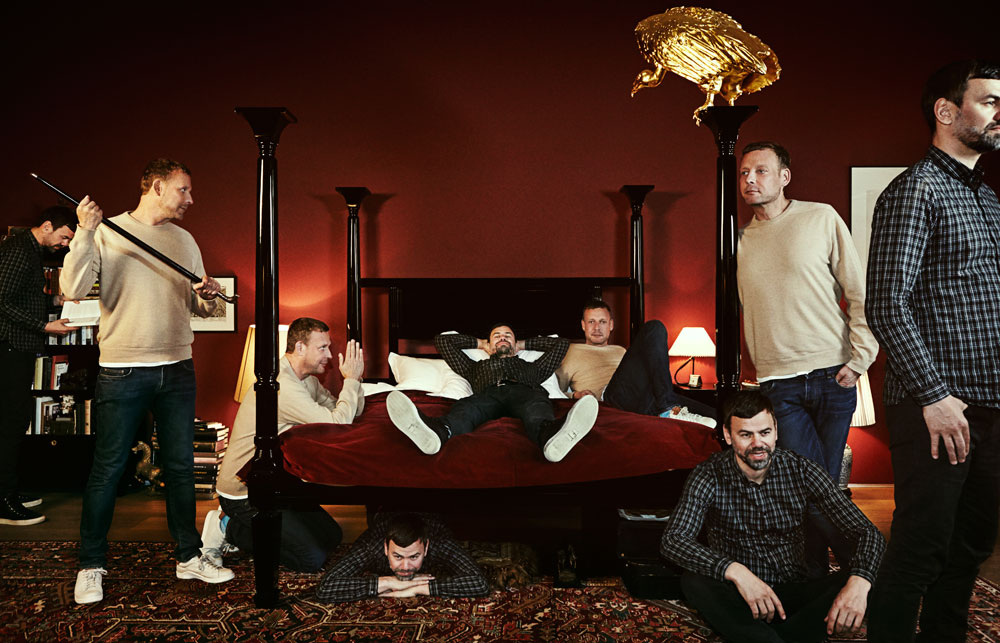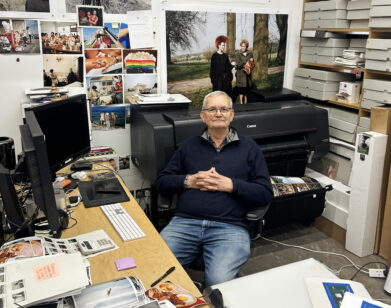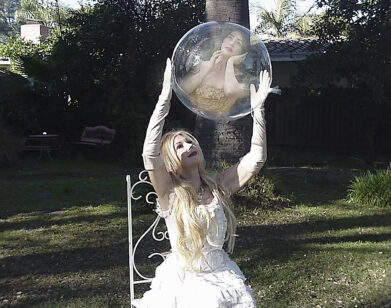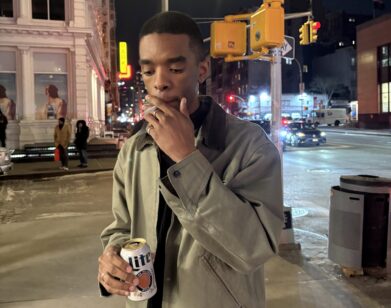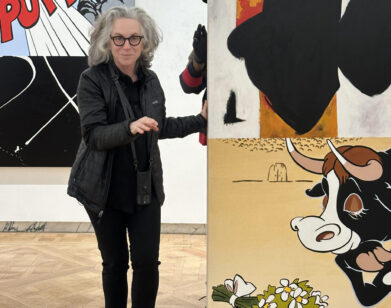Mr. Swann Moves to New York
MICHAEL ELMGREEN AND INGAR DRAGSET IN NEW YORK, APRIL 2015. PHOTOS BY CHRISTIAN HÖGSTEDT.
Perhaps most widely recognized for their permanent installation in Marfa, Texas, the artist duo Elmgreen & Dragset is known for humorous, yet politically and socially driven immersive works of art. In Texas, on the side of U.S. Highway 90, stands a small, one-floor building that imitates a Prada store, completed with shoes, handbags, and the fashion label’s signature font. Since Prada Marfa‘s construction in 2005, Michael Elmgreen and Ingar Dragset have exhibited around the world. At 2009’s Venice Biennale, they presented a mysterious fictional character Mr. B who drowned in a pool. In their landmark solo show “Tomorrow” (2013) at the Victoria and Albert Museum in London, they created a multi-room home for yet another fictionalized character, Norman Swann. Now, at the age of 78, the tired, disillusioned, and unsuccessful architect Mr. Swann has moved to New York—a story told and visualized through Elmgreen & Dragset’s new exhibition, “Past Tomorrow,” at Galerie Perrotin.
“It was obvious that Norman would leave London after being humiliated and going bankrupt, and try to reinvent himself in a new place,” Elmgreen explains. “We saw Emmanuel [Perrotin]’s space here in New York, and were sure this would be the new home for Norman.”
Showing in New York for the first time in 10 years, Elmgreen and Dragset converted the high-ceilinged, Upper East Side gallery space into Swann’s studio apartment. Deep red walls, a black lacquered four-poster bed, and subtle, telling details of Swann’s life (his collection of books, a drawing desk with unfinished building plans, a bedside table complete with medicine and cigars) enhance the neo-classical architectural details. It becomes apparent that Swann chose to bring certain items, such as his nightstand with its Truvada and Preszista—medicine used to treat HIV—and gold-plated vulture, transatlantic. Yet, while recurring elements allude to the former Oxford professor’s personal history and struggles of decades past, newly created items, such as the modern bed, paired with Swann’s current displacement and reinvention, can be read as an allegory of Europe’s current cultural confusion.
Accompanying “Past Tomorrow” is a small book that features a fictionalized interview between Swann and a journalist in New York, as well as scenes from an unrealized film, featuring Swann and his former student, Daniel Wilder, which were originally presented alongside the show at the V&A. We met Elmgreen and Dragset at Galerie Perrotin just before the opening of the exhibit. When we walked into the gallery’s private office, there were two armchairs and a couch…
INGAR DRAGSET: So if you lay down, we will ask the questions. [laughs]
EMILY MCDERMOTT: Psychoanalyze me? So this is the continuation of the show at the V&A and there are recurring elements, like the bedroom table. How did you choose which elements you wanted to bring over?
MICHAEL ELMGREEN: When we did the show at the V&A, we made it so you knew that our main character would move out of the flat. There were moving boxes everywhere, but he didn’t really know where to go yet, the poor Norman Swann. Then we saw Emmanuel’s space here in New York and thought, “Wow, this is perfect,” because it had these neo-classical features. We decided that Norman would move to New York.
MCDERMOTT: How do you think New York is going to change Norman, or has it already changed him?
DRAGSET: In our fiction he’s already lived there in the ’80s, at a very difficult time. We know he’s an older, homosexual man, who was out and about during the ’80s. [laughs] It seems also that he contracted HIV at the time, but was one of the people lucky enough to survive and get medicine. But now, maybe he’s a bit surprised that he’s lived for so long. He’s sort of a very reflective type, I think, thinking about what life means, “What have I done?”
ELMGREEN: It was an actual problem, for a whole generation that was counting on not living for so long. Then suddenly, the medicine came, and it was possible to continue your life. Then they’re like, “What the fuck do we do with that extra time?” Maybe you used all your money, maybe you cashed in your life insurance, then suddenly you have much more time than you expected.
MCDERMOTT: So how did you first come up with the character Norman? When was the initial moment you were like, “Let’s create this character”?
DRAGSET: The starting point was an invitation to do an exhibition at the Victoria and Albert Museum. The curator had seen our Venice Pavilion, in 2009, where we created these fictional homes, and thought it could be fun if we came in and dealt with their collection, which has a lot of design objects and art historical artifacts—every day objects as well as antiques and very valuable artifacts. We thought this would be amazing; it’s such an incredible playground, such an incredible source of objects. We saw the possibility to use these objects and create a story through them, combined with our own artworks. That was the very, very beginning.
And then [Michael], I think your experience living in London for the last six years, that could be one inspiration—Europe’s identity crisis, the British Empire not really existing anymore, a worldview that’s not the same anymore for Europeans, but you’re still trying to hold onto some values that have been developed for the last hundreds of years.
ELMGREEN: Europe has an identity crisis at the moment—from being the big brother in the world to suddenly having outplayed its power position a bit—and doesn’t really know what to do now. You feel it in England, you feel it in London, where you have new money coming in from everywhere, like Middle Easterns, Chinese, Russians. The old traditional British upper class are certainly finding themselves servicing this new money, almost being butlers for the new rich coming into town. There’s a whole change of the roles.
I was at a dinner not long ago, where the person next to me had just got an OBE [Order of the British Empire]—we have an OBE medal [hanging amidst] the different drawings and photos—and I asked him, “How can it be that this medal has not shrinked according to the British Empire?” It should, actually, be a tiny little medal today, because there’s only the four lands left in The British Empire. He didn’t think it was funny. [all laugh]
DRAGSET: So you could say that Norman is, in a way, a symbol of the decline of the European identity. Also, Norman is, of course, in a way, true of Michael and me.
MCDERMOTT: I was going to ask if he was an extension of yourselves…
DRAGSET: In a way, yes.
ELMGREEN: A warning.
DRAGSET: A warning to ourselves, maybe.
ELMGREEN: We hope we don’t turn into so grumpy, bitter, old men, like Norman. [Although,] truth be told, he does have traits that are reflective of our own, but not the most charming ones.
DRAGSET: Such as being a little bit too aggressive, or very stubborn. I won’t say which one [of us] is what. [laughs] He maybe gives up a little too early if he faces a resistance.
MCDERMOTT: Have you found yourselves giving up if you face a resistance?
ELMGREEN: Oh yeah. We are bad masochists. [both laugh] I mean, if it doesn’t function, then we just come up with something else, somewhere else.
MCDERMOTT: So there’s no problem solving. It’s just moving away to a different project?
DRAGSET: This is becoming psychotherapy!
MCDERMOTT: What about the character Charles, who interviews Norman in the dialogue? Who is he?
ELMGREEN: He’s planning to make a portrait of Mr. Swann moving to New York. But, Daniel, his former student who bought the apartment in South Kensington, is new money.
DRAGSET: Charles hasn’t had any influence on Norman’s life. He’s just someone who tries to understand where Norman is now, you know, “What has he done? Why is he here again, back in New York?” But in the script, further back, you get to understand that Daniel has actually been very close to Norman. He’s definitely the new money, or someone that maybe sells out, or has sold out, and doesn’t mind. He’s more representative of the new generation. He’s more client-focused and can do whatever, as long as it pays.
ELMGREEN: He’s an interior designer, who’s tremendously successful because he does the homes for all the new rich people in London. It’s of course something that Norman Swann, the old architect, is looking down upon, because he’s standing up for socially engaged architecture. The problem for Norman is that he never got anything realized, whereas Daniel was more pragmatic. That’s one thing I don’t like so much about Norman; he’s very snobbish.
MCDERMOTT: When you’re creating these characters, you’re writing a book but also visualizing it. What is your process?
ELMGREEN: In the writing process, it’s really developing and writing paragraphs, and sending it to each other…
ELMGREEN: Little scenes we weave together…
MCDERMOTT: So do you know the bigger picture of Norman’s story before you write it?
DRAGSET: The frame we know, but it changes direction. This story changed directions according to how the exhibition developed and what our possibilities were. We got more space throughout the process at the V&A, so we could do it even bigger. It was taking new turns according to that.
MCDERMOTT: Where do you find all the objects you include in the shows?
ELMGREEN: A lot of it looks like found objects and readymades, but we have actually made them ourselves.
DRAGSET: Many are altered, like the black furniture, for instance. That is custom made. But there are other artifacts that are found at antique shops or thrift stores.
ELMGREEN: But photos have been staged, for instance, so they look like old photos. Some are archive photos, but others are staged so they look old. The poster on the wall seems like a real exhibition from that time, but it’s made up. A lot of things look like readymades, but actually, we made them.
DRAGSET: It’s great to have this perspective. It stays with you all the time. You go to different countries and you see something that maybe you don’t like yourself, but you think, “Oh maybe Norman will like this!”
MCDERMOTT: So is Norman always in your head?
DRAGSET: Yes, more and more over the last few years.
ELMGREEN: In Venice, we had a mysterious Mr. B who had drowned face down in the pool outside the pavilion. We made another show with him as well, continuing his story, telling about how he ended up in the pool. So we have these characters that are almost like family members following us.
MCDERMOTT: It’s a whole world that you’re creating. Did you have imaginary friends growing up?
DRAGSET: I had a little stick! [laughs] A stick that was a figure…I had one terrible year. I was nine and we moved to a different city. For one year, we lived in this terrible suburb; everyone was mean and there were no rules. That year, I had this stick that was coming with me everywhere. I remember sitting in the tree with the stick… [laughs]
MCDERMOTT: Michael, did you have anything like that?
ELMGREEN: No, but I invented a lot of stories and was often punished because I was lying. But I believed in these stories that I would tell. Maybe I was bored; I was making reality more fantastic than it actually was.
DRAGSET: Everyone loved the story about the circus, but that was partly true…
ELMGREEN: Oh, that was true! I had a girlfriend when I was five years old, and her family owned a circus in Denmark. They said to me I could have a baby elephant from the circus, but I was living in an apartment building. That was when I started hating my parents because they said to me, of course I couldn’t have a baby elephant in an apartment building, which was quite logical, but I absolutely could not understand why it couldn’t just be in the basement and I took care of it. I said, “You are the most evil persons on planet Earth.” I really, really, really hated them for half a year because I couldn’t have that elephant. I would never have done art if I had gotten that elephant because I would have been living it all out! But, I didn’t get it, and then I had to invent new realities.
DRAGSET: I adopted an elephant for Michael as a birthday present at his last big birthday. So he actually does own an elephant in Indonesia, but it’s supporting a wildlife elephant in Indonesia. [laughs]
MCDERMOTT: So I noticed that Norman has a very old computer in a box, but no new or functioning computers. What’s the reasoning there?
DRAGSET: He might have an iPhone 6 somewhere for all I know. [laughs] He’s an old-fashioned guy.
ELMGREEN: It is possible to live without Internet. We are old enough to have experienced it. It’s kind of fun to speak with the kids who are really young today, like teenagers; they’re more against the obsession with Internet. At cool parties, it’s a no-go to take out your phones and take pictures, or do art shows that are Instagrammed. It’s the most uncool thing to do, because it’s not about mediating; it’s about being there in real life, real time, and experiencing, and to keep a certain degree of integrity. All kinds of subcultures have been absorbed within days by mainstream media. It’s impossible if you’re a teenager today to insist upon your own culture, your own youth culture. I think, at least in Europe, it has started backtracking—not being on Facebook, not Instagramming, not being addicted to all this, but go to real, live gigs, and hang out with your friends.
MCDERMOTT: Then in terms of the objects, you encourage people to pick them up and look at what it is. Some of it is very particularly placed, so how do you deal with it if it gets moved? If that even plays a role?
DRAGSET: Things happen, but it was fantastic at the V&A because so little was nicked at. Sometimes people are so freaked out about anything being touched, but we have only positive experiences. People are quite respectful.
ELMGREEN: Exactly, because it is such a domestic setting, people behave like guests, and if you’re a guest in someone’s home, you also don’t freak out and destroy everything.
MCDERMOTT: This is true, you pick it up and put it back where it came from…at least most people. [all laugh]
ELMGREEN: I remember stealing a Eurythmics record from someone when I was 16. I’m still a bit embarrassed about it.
MCDERMOTT: You saying that makes me realize that Norman doesn’t appear to have any music…
DRAGSET: He does! There’s a little cassette player. No one has pressed it yet.
ELMGREEN: There is piano music on it. The story doesn’t really tell if it’s Norman himself playing.
DRAGSET: The style is very much like early Philip Glass. It’s clearly American music.
MCDERMOTT: Where is Norman going now?
DRAGSET: Norman is staying here. He is a little bit hesitant about contacting old friends, he’s been out of touch for a long time, but I think he’s going to try to see some old friends and reconnect.
ELMGREEN: He has an appointment with his doctor. There is a business card from a local doctor stuck in the mirror, above the fireplace. But aside from that, he’s sitting in Central Park, talking to himself. [laughs]
“PAST TOMORROW” IS ON VIEW AT GALERIE PERROTIN IN NEW YORK THROUGH MAY 23.

